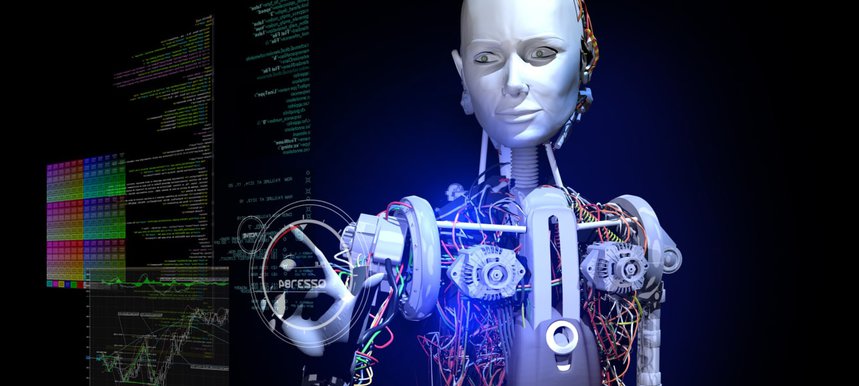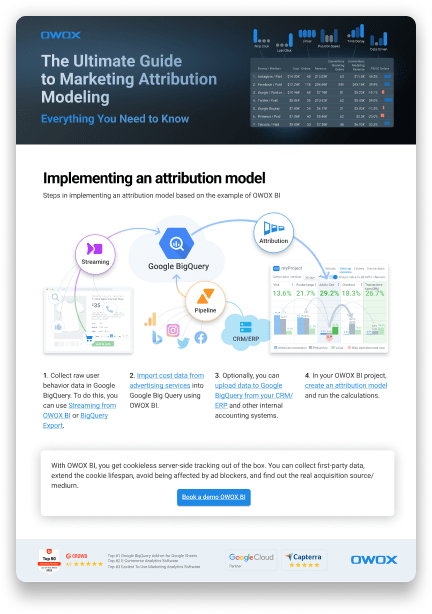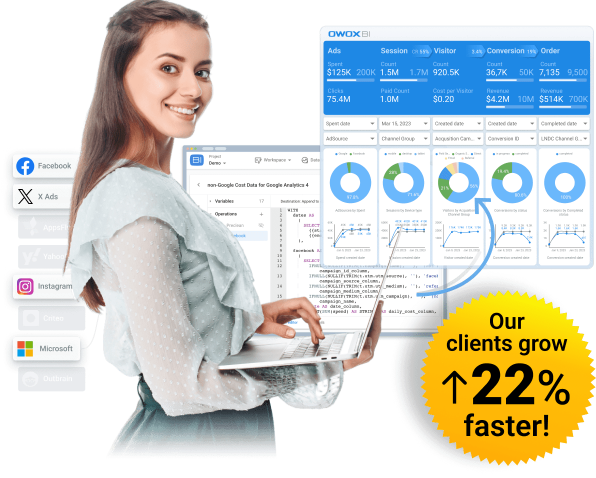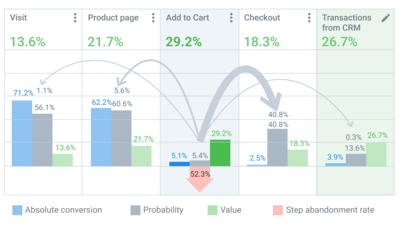Exploring Machine Learning in Digital Marketing with Examples
Vlada Malysheva, Creative Writer @ OWOX
A couple of decades ago, the first thing that came to mind when you heard the words “artificial intelligence” was likely the rise of machines and the Terminator with a sawed-off shotgun. Today, this term has rather positive associations. Almost everyone encounters machine learning in ordinary life. For example, you might communicate with a chatbot on a website, be shown promotional offers corresponding to your hobbies, or set up a spam filter in your email service.

For marketers, machine learning is an opportunity to make crucial decisions based on big data quickly. In this article, we’ll talk about what decisions you can make based on big data.
Note: This post was originally published in August 2020 and was completely updated in January 2024 for accuracy and comprehensiveness.
What is machine learning?
Let’s start with a little terminology. According to Wikipedia, machine learning (ML) is a class of artificial intelligence methods characterized by their not providing direct solutions to problems but rather training systems to apply solutions.
There are many methods of machine learning, but they can roughly be divided into two groups:
learning with a teacher
learning without a teacher.
In the case of learning with a teacher, a person supplies the machine with initial data in the form of situation–solution pairs. The machine learning system then analyzes these pairs and learns to classify situations based on known solutions. For example, a system can learn when to mark incoming messages as spam.
In the case of learning without a teacher, the machine receives unsorted information — situations — without solutions and learns to classify those situations based on similar or different signs without human guidance.
Machine learning in Digital Marketing
Digital Marketers use machine learning to find patterns in user activities on a website. This helps them predict the further behavior of users and quickly optimize advertising offers.
What is the potential of behavioral data of the users?
In psychology, a pattern is a particular set of behavioral reactions or a common sequence of actions. Therefore, we can talk about patterns with regard to any area where people use templates (which is most areas of life).
Consider the example of a pattern used on websites. If the user isn’t interested in the offer in the pop-up window shown below, they can close this window by:
- clicking on the X sign
- clicking No thanks
- clicking anywhere on the site that’s outside the pop-up window.

In addition to these three actions the user can take, the pop-up window will close on its own after a certain period of time.
So we get four possible user actions:
- Click X — Can be true/false
- Click No thanks — Can be true/false
- Click past the pop-up — Can be true/false
- Pop-up viewing time is 5 seconds
When hundreds of such parameters are collected, the collected data gains value because it contains behavior patterns and dependencies. It hides the enormous potential of behavioral data, allowing us to supplement user data with the missing parameters based on the data we already have for other users.
For example, the simplest way to define a target audience is by gender and age. But what if users fill out this data only in 10% of cases? How can you understand how many of your website users fall into your target audience? Patterns of behavior can help.
You can use gender and age data from 10% of users to determine patterns specific to a particular gender and age. Then you can use these patterns to predict the gender and age of the remaining 90% of users.
Having complete data about gender and age, you can now make personalized offers to all website visitors.

Gain clarity for better decisions without chaos
No switching between platforms. Get the reports you need to focus on campaign optimization
Why machine learning is effective in marketing
The role of machine learning in marketing is to allow you to make decisions based on big data quickly.
The algorithm for the work of marketers is as follows: Marketers create hypotheses, test them, evaluate them, and analyze them. This work is long and labor-intensive, and sometimes the results are incorrect because information changes every second.
For example, a marketer will need about four hours to evaluate 20 advertising campaigns considering 10 behavioral parameters for five different segments. If such an analysis is carried out daily, the marketer will spend precisely half their time assessing the quality of campaigns. When machine learning in digital marketing is used, evaluation takes minutes, and the number of segments and behavior parameters is unlimited.
With machine learning, you can respond faster to changes in the quality of traffic brought by advertising campaigns. As a result, you can devote more time to creating hypotheses rather than to carrying out routine actions.
The value of your results depends on the relevance of the data on which the analysis was conducted. As data becomes obsolete, its value decreases. A person simply can’t process the volumes of information that are collected every minute by analytical systems. Machine learning systems can process hundreds of requests, organize them, and provide results in the form of a ready answer to a question.
Key benefits of machine learning in marketing:
- Improves the quality of data analysis
- Enables you to analyze more data in less time
- Adapts to changes and new data
- Allows you to automate marketing processes and avoid routine work
- Does all of the above quickly
Uncover in-depth insights
The Ultimate Guide to Marketing Attribution Modeling: Everything You Need to Know
Download nowBonus for readers

Examples of machine learning in marketing
Machine learning is transforming marketing through data-driven insights and automated decision-making, enhancing customer understanding and campaign effectiveness. In the following sections, we'll explore specific examples of machine learning in digital marketing:
1. Customer Lifetime Value Prediction
Essence: Estimating the total value a customer will bring to a company over the entire duration of their relationship.
What it predicts: The potential revenue a customer can generate in the future.
How this data is used: To prioritize marketing and sales efforts and tailor retention strategies for high-value customers.
Result: More efficient resource allocation and a focus on cultivating long-term customer relationships.
Common algorithms for this purpose: XGBoost, SVM, Random Forest, and Logistic Regression.
Examples: E-commerce platforms like Amazon use CLV prediction to identify high-value customers. By analyzing purchase history, browsing behavior, and product reviews, they can forecast future buying habits. Such insights allow them to provide these high-value customers with premium services, such as exclusive offers or early sales access, which encourages continued loyalty and spending.
2. Sales Forecasting
Essence: Estimating future sales.
What it predicts: Expected sales for a future period based on historical data.
How this data is used: To make inventory, staffing, and other business decisions.
Result: Optimized operations and better preparation for market demands.
Common algorithms for this purpose: ARIMA
Examples: Walmart, in anticipation of major events like Black Friday, leverages sales forecasting to optimize inventory management. The company predicts upcoming product demand based on past sales data, current market dynamics, and existing inventory levels. This analytical approach allows retail giants, including others like Target, to be adequately stocked and prepared, ensuring they meet consumer demand during peak shopping seasons.

Spend Smarter, See Results Sooner
Learn how to optimize every marketing dollar with personalized insights from OWOX BI
3. Churn Rate Forecasting
Essence: Determining the likelihood of customers discontinuing their use of a product or service.
What it predicts: Which customers are at risk of leaving or not renewing their subscriptions?
How this data is used: To engage at-risk customers with retention strategies, special offers, or personalized communications.
Result: Reduced customer turnover, sustained revenue streams, and insights into potential areas of improvement.
Common algorithms for this purpose: Support Vector Machines, Logistic Regression
Examples: Verizon, a telecom giant, could predict churn by examining factors like call drop rates, customer service interactions, and changes in monthly bill amounts. By identifying customers who exhibit behaviors indicative of churn, they can proactively engage them with targeted promotions, personalized offers, or service improvements to retain their business
4. Customer Segmentation
Essence: Grouping customers based on shared characteristics, behaviors, or preferences.
What it predicts: Which segment does a particular customer belong to?
How this data is used: To tailor marketing messages, offers, and product recommendations for different segments.
Result: More targeted and personalized marketing, leading to better customer engagement and increased sales.
Common algorithms for this purpose: Hierarchical Clustering, and K-means clustering.
Examples: Netflix employs machine learning to categorize its audience according to their watch history, favorite genres, frequency of streaming, and device preferences. This enables Netflix to refine content suggestions, and craft targeted marketing strategies for diverse user groups.
5. Predictive Analytics
Essence: Anticipating future outcomes based on historical and current data.
What it predicts: Potential future events such as sales trends, customer behaviors, or market changes.
How this data is used: To make informed decisions, prepare for future demands, and optimize strategies.
Result: Proactive business decisions that align with anticipated market needs.
Common algorithms for this purpose: Linear Regression, Decision Trees.
Examples: Using predictive analysis, Walmart refines its store inventory planning approach. By scrutinizing historical sales patterns, factoring in seasonal changes, and integrating insights from local events and promotions, the retailer optimizes its stock levels, adeptly reducing excesses and safeguarding against product deficits.
6. Chatbots and Virtual Assistants
Essence: Automating customer interactions and service requests.
What it predicts: The intent and context behind a user's question or statement.
How this data is used: To provide relevant responses or actions.
Result: Quick, consistent, and scalable customer support or engagement.
Common algorithms for this purpose: Natural Language Processing (NLP) and Seq2Seq models.
Examples: Google Assistant doesn't just respond to queries; it uses machine learning to understand context, user preferences, and even nuances in voice tone. This continuous learning allows it to provide more accurate and personalized responses over time.
7. Email Marketing Optimization
Essence: Enhancing the effectiveness of email campaigns.
What it predicts: Best send times, optimal content, and target audience for email campaigns.
How this data is used: To send emails with higher open rates, click-through rates, and conversions.
Result: Improved engagement and ROI from email marketing campaigns.
Common algorithms for this purpose: Random Forest.
Examples: Mailchimp doesn't only send emails. Analyzing metrics like open rates, click-through rates, and conversion rates can suggest optimal send times, content tweaks, or audience segmentation to ensure the best engagement for each campaign.
8. Ad Targeting
Essence: Displaying the most relevant advertisements to users.
What it predicts: Which ad a specific user is most likely to engage with?
How this data is used: To place ads in front of the most suitable audience.
Result: Higher ad engagement, click-through rates, and conversion rates.
Common algorithms for this purpose: Logistic Regression, and Decision Trees.
Examples: Nike collaborates with platforms like Facebook and Instagram to launch its new shoe. These platforms use machine learning to analyze user interests and behaviors, pinpointing long-distance runners. Nike then delivers personalized ads highlighting the shoe's benefits to this targeted group, resulting in increased engagement and efficient ad campaign performance.
9. Sentiment Analysis
Essence: Gauging public sentiment from text data.
What it predicts: Positive, negative, or neutral sentiment of a given piece of text.
How this data is used: To understand customer opinions, feedback, and overall brand perception.
Result: Informed strategies that address customer concerns and leverage positive feedback.
Common algorithms for this purpose: NLP.
Examples: Using machine learning, platforms like Yelp can automatically categorize user reviews based on their sentiment. By parsing the text, Yelp swiftly discerns whether a review leans positive, negative, or neutral. This approach not only streamlines the user experience by highlighting prevailing sentiments but also offers businesses a consolidated view of customer feedback, facilitating more effective responses.
10. Website Content Optimization
Essence: Dynamically adjusting website content based on user behavior.
What it predicts: Content or layout that a specific visitor is most likely to engage with.
How this data is used: To personalize the website experience for individual visitors.
Result: Higher engagement, lower bounce rates, and improved conversion rates.
Common algorithms for this purpose: Multi-Armed Bandit, and Reinforcement Learning.
Examples: Online platforms like The New York Times utilize machine learning to enhance user experience by tailoring content displays. The site can make informed decisions by tracking and analyzing user behavior, like their reading preferences and frequency. If a user frequently engages with tech articles, the algorithm ensures those topics are more prominently showcased on their homepage or suggested articles list. This results in a more personalized user experience, encouraging longer site visits, increased engagement, and greater loyalty to the platform.
11. Attribution Modeling
Essence: Determining the impact of different marketing touchpoints.
What it predicts: The contribution of each touchpoint to a conversion.
How this data is used: To allocate budget and focus on the most impactful marketing channels.
Result: Optimized marketing spending and strategy.
Common algorithms for this purpose: Logistic Regression, Random Forests, and Shapley Value.
Examples: Airbnb aims to understand the effectiveness of its diverse marketing channels in driving bookings. Through this method, they can trace the entire customer journey, from an initial touchpoint, such as a Facebook ad, a Google search result, or an email campaign, to the final booking. This insight helps them optimize their marketing budget by focusing on the most impactful channels. Tools like Google Analytics assist businesses in comprehending the customer's path by showcasing the influence of various touchpoints, whether they're search ads, display ads, or other campaigns, in achieving desired conversions.

Don't just guess.
Attribution modeling in OWOX BI brings clarity to your marketing
Machine learning in attribution
Why is machine learning in digital marketing needed, and how does it help you solve the attribution problem? This is a topic for a separate article (which we’re already preparing).
In this article, let’s figure out at what level decisions are made using attribution. We’ll compare these levels based on several criteria:
The level itself
Key decision-makers
Types of decisions made
Tools used
Attribution models most often employed
Levels at which attribution-based decisions are made:
1. Vision Level
Who: A company’s vision is formed by its board of directors, CEO, and marketing director.
When: Quarterly, yearly
What: Vision-level decisions are associated with investments in the brand and balancing budgets between online and offline.
How: The tools used to make such decisions are market research and consultants.
Model: There’s rarely a place for classical data-based attribution models since the data on which decisions are based is not digitized enough.
2. Strategic Level
Who: Strategic decisions are made monthly by marketing and e-commerce directors.
When: Monthly
What: These decisions are devoted to allocating the budget between channels and defining the top-level KPI.
How: The tools that help in making strategic decisions are Visual IQ, OWOX BI, or casual models.
Model: Here, the business uses data-driven attribution by GA4, variations on the theme of the Shapley value and Markov chains, or machine-learning funnel-based attribution. At this level, it’s important to understand the mutual influence of channels and make strategic decisions on their development.
Examine the advantages and disadvantages of popular attribution models, ranging from standard ones to Markov chains, Conversion Lift, and Machine-Learning Funnel Based models.
3. Tactical level
Who: Usually, tactical decisions are made weekly or even more frequently by the manager of paid traffic acquisition.
When: Weekly
What: Budget allocation occurs between campaigns and ad sets, and decisions are aimed at clarifying KPI and campaign goals.
How: For making tactical decisions, you can use Google Sheets or OWOX BI.
Model: Often at this level, specialists use standard attribution models
The peculiarity of this stage is that the budget for a channel has already been allocated. So at this point, it’s important to understand what campaigns to spend it on, control the results, and quickly turn off inefficient campaigns.
4. Execution Level
Who: Bid manager
When: Nearly in real-time
What: This is when the decision to evaluate the contribution of a particular announcement or keyword occurs in close to real-time.
How: Such decisions are typically made inside advertising services (Google Ads, Facebook Ads).
Model: In fact, the customer doesn’t care what optimization mechanisms are used here, as they look at the results of each service separately.
As you can see, machine learning in digital marketing is most useful for strategic and tactical tasks. Sometimes, it’s also applied at the execution level, but the general trend is that advertising systems develop fast and have a lot of data. The internal algorithms used in these systems to manage advertising campaigns produce better results than an external model based on machine learning.
The reason is that to apply machine learning in marketing, it’s necessary to export large amounts of data from the advertising service quickly and then quickly import results back. Technically, this is a difficult task to solve on an industrial scale. Therefore, at the execution level, marketers tend to rely on internal algorithms for optimizing advertising services.
To use machine learning to solve tactical and strategic problems, you need to ensure the completeness of your data. You can do this with OWOX BI.
OWOX combines data from your website, advertising services, and CRM so you can automate your marketing reporting and build the attribution model you trust to grow your brand’s ROI.
How OWOX BI uses machine learning
Machine learning segmentation
OWOX BI has developed our ML-based solution, which calculates the probability of purchasing considering the purchased orders for each website user. Based on this calculation, you can create audiences, and use them to target advertising campaigns and 2X ROI, as one of our customers did.
Features of ML segmentation with OWOX BI
The OWOX BI model can be trained on data from different sources: CRM, websites, and mobile applications. Our solution allows selecting any targeted action: transactions, purchased goods, phone calls, adding goods to the cart, etc.
You can also set any period relevant to your business as a conversion window, depending on the timing of the purchase decision.
You can use the calculation results in different advertising services: Google Ads, Facebook, Instagram, etc.
You can use conversion prediction results to:
Adjustment bids in search or display ads.
Improve targeting in media campaigns.
Set expectations in media campaigns.
Increase incoming traffic, buy more widely and cheaper, and adjust the ads after user assessment.
Book a demo to learn more about ML segmentation opportunities for your business.
Conversion Lift attribution with OWOX BI
The Conversion Lift attribution model is based on ML and shows the incremental contribution of each channel and campaign to the sale. That is why you can immediately analyze any launched campaign without waiting months to get a full overview, even if the sale would take place only in the future.
For example, you have launched campaigns that work on the top or middle of the funnel. And you need to get quick feedback on the impact of these campaigns on sales over the past week.
This assessment can be carried out with Conversion Lift as early as the first week after the launch. You purchased traffic today. You don’t have sales yet, but you can already estimate the contribution to future sales.
In OWOX BI, you can connect any standard attribution model to your reporting. Also, our analysts can configure any algorithmic model based on conversion forecasting or a custom model for your rules and sales funnel.
You can analyze your digital campaigns from different angles, compare the results of calculations on several attribution models, and choose the one that is designed to suit your business goals.
Sign up for a demo and we’ll show you how OWOX BI attribution works. Our expert team will show you real-world examples of how to select the right attribution model for your business and how you can benefit from that.
Key Takeaways
Machine learning helps marketers use data to make better decisions, improve campaigns, and understand customers. It allows for accurate sales forecasts, targeted ads, and personalized marketing strategies, boosting business performance and customer satisfaction.
To use machine learning to solve tactical and strategic problems, you need to ensure the completeness of your data. You can do this with OWOX BI. OWOX combines your data from your website, advertising services, and CRM so you can create a funnel that takes into account the peculiarities and efforts of your business and is aimed at attracting customers and growing sales.

Gain clarity for better decisions without chaos
No switching between platforms. Get the reports you need to focus on campaign optimization
FAQ
-
What kind of positive impact will machine learning have on the advertising industry?
Machine learning enhances advertising through precise targeting, personalization, dynamic pricing, ad optimization, fraud detection, predictive analytics, automation, content recommendations, customer insights, A/B testing, voice/image recognition, and cross-channel integration. -
What impact has machine learning made on the marketing industry?
Machine learning has a significant impact on the marketing industry, transforming how businesses understand, target, and engage with their customers. Here are some key ways in which machine learning has influenced marketing: 1. Data-driven insights. 2. Hyper-personalization. 3. Predictive analytics. 4. Content optimization. 5. Chatbots for customer support. 6. Targeted ad campaigns. 7. Fraud prevention. 8. Marketing automation. 9. Faster A/B testing. -
Why is machine learning effective in marketing?
The role of machine learning in marketing is to allow you to make decisions based on big data quickly. With machine learning, you can respond faster to changes in the quality of traffic brought by advertising campaigns. As a result, you can devote more time to creating hypotheses rather than carrying out routine actions. -
What is machine learning?
According to Wikipedia, machine learning (ML) is a class of artificial intelligence methods characterized by their not providing direct solutions to problems but rather training systems to apply solutions. -
Examples of machine learning in marketing
1. Recommendation systems
2. Forecast targeting
3. LTV forecasting
4. Churn rate forecasting









